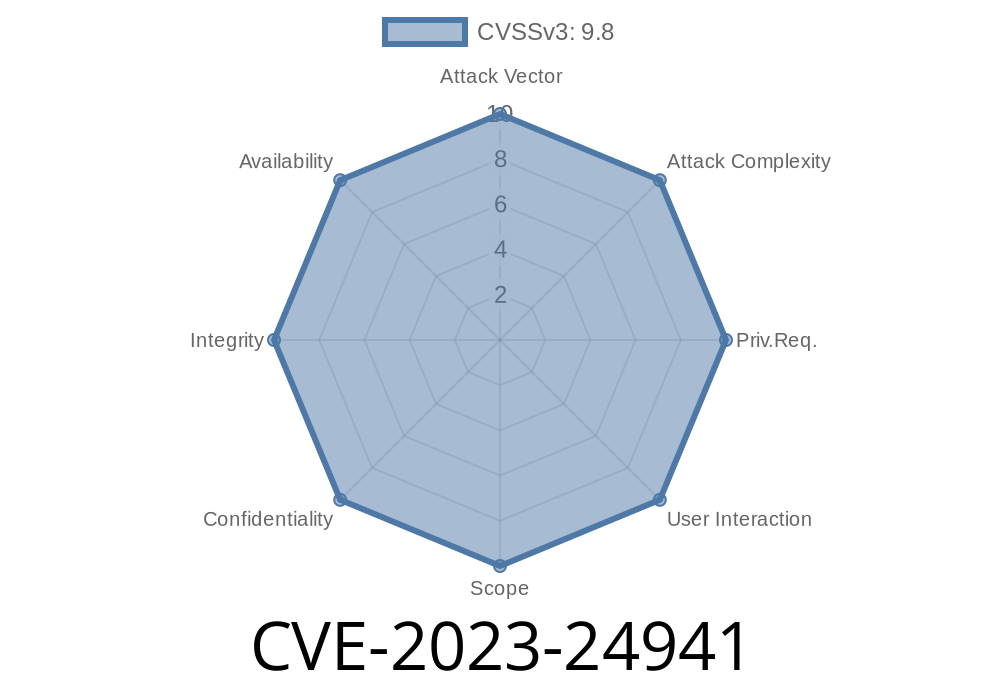On May 9, 2023, Microsoft released a patch for a serious vulnerability dubbed CVE-2023-24941. This flaw exists in the Windows Network File System (NFS) and, if exploited, can allow remote attackers to execute arbitrary code on affected systems. In this guide, we’ll walk through what CVE-2023-24941 is all about, how it works, as well as provide examples and reference links. We’ll keep things simple while providing enough technical depth for IT pros and enthusiasts.
What Is CVE-2023-24941?
CVE-2023-24941 is a Remote Code Execution (RCE) vulnerability targeting the NFS service in Windows servers. Attackers can exploit this flaw over a network by sending specially crafted requests to an NFS server, potentially gaining full control over the machine running the service.
Affected Systems:
Windows Server 2012, 2016, 2019, and 2022, where NFS role is enabled.
NFS:
The Network File System protocol is used to share files and folders across networks, primarily in UNIX/Linux environments but also supported in Windows via the File and Storage Services role.
At its core, CVE-2023-24941 is a memory corruption vulnerability. Here’s a breakdown
1. Sending Malicious Requests: An attacker sends a crafted RPC (Remote Procedure Call) message that interacts with the NFS service in a way that causes a buffer overflow or controls memory pointers.
2. Triggering Execution: If successful, the attack can overwrite certain areas of memory, controlling the flow of the application and eventually executing malicious code.
3. Remote Control: The attacker can then execute code with SYSTEM/user privileges, potentially taking over the server.
Visual Breakdown
flowchart TD
Attacker[Attacker] -->|Malicious NFS Request| WindowsNFS[Windows NFS Service]
WindowsNFS -->|Buffer Overflow| Memory[Memory Corruption]
Memory -->|Executes Payload| Attacker
Proof-of-Concept (PoC) Code Example
While full exploit codes are not officially released due to the severity, here’s a safe pseudo-example showing how an attacker could use Python’s socket library to send crafted NFS packets:
import socket
# Simple example: connect to target NFS server (port 2049)
target_ip = '192.168.1.100'
target_port = 2049
# Crafting a malicious packet (illustrative only)
payload = b"\x80\x00\x00\x00" # RPC message header (may need adjustment)
payload += b"A" * 1024 # Overflow with 'A's
with socket.socket(socket.AF_INET, socket.SOCK_STREAM) as s:
s.connect((target_ip, target_port))
s.sendall(payload)
print("Malicious NFS packet sent.")
> Warning: This code is just for educational illustration and does NOT actually exploit the vulnerability. Never attack unauthorized systems.
Microsoft Security Advisory:
msrc.microsoft.com/update-guide/vulnerability/CVE-2023-24941
NIST NVD:
nvd.nist.gov/vuln/detail/CVE-2023-24941
Rapid7 Analysis:
Update Immediately:
Patch your affected Windows Servers using Windows Update or grab direct links from the Microsoft Patch Tuesday page.
Monitor NFS Servers:
- Watch for unusual traffic to port 2049/TCP.
Frequently Asked Questions
Q: Does this affect client computers, or only servers?
A: Only systems running the Windows NFS service (i.e., typically servers) are affected.
Q: Is there an exploit in the wild?
A: As of the latest updates, active exploitation is not widespread, but given the criticality, exploits may appear.
Q: What if I only use SMB, not NFS?
A: If the NFS service/role is not enabled on your server, your system is NOT vulnerable.
Final Thoughts
CVE-2023-24941 is a powerful reminder to patch exposed network services right away. Even if you don’t use NFS daily, the service may be enabled as part of larger storage solutions on Windows servers. Review your configurations, patch quickly, and limit exposure to network-accessible services.
Stay safe, and always keep your systems up-to-date!
*Written exclusively for you by your AI Security Analyst.*
Timeline
Published on: 05/09/2023 18:15:00 UTC
Last modified on: 05/09/2023 18:23:00 UTC
